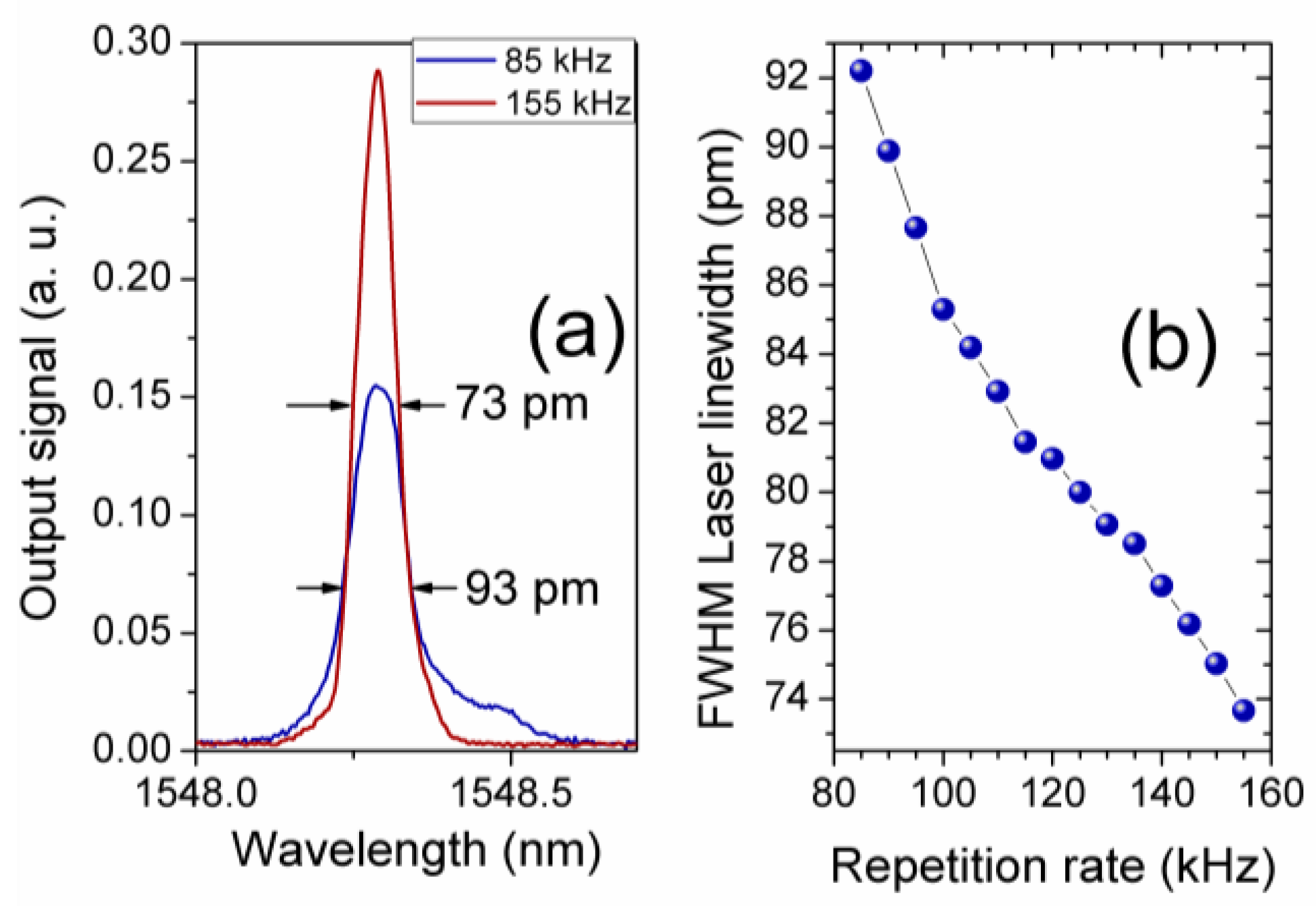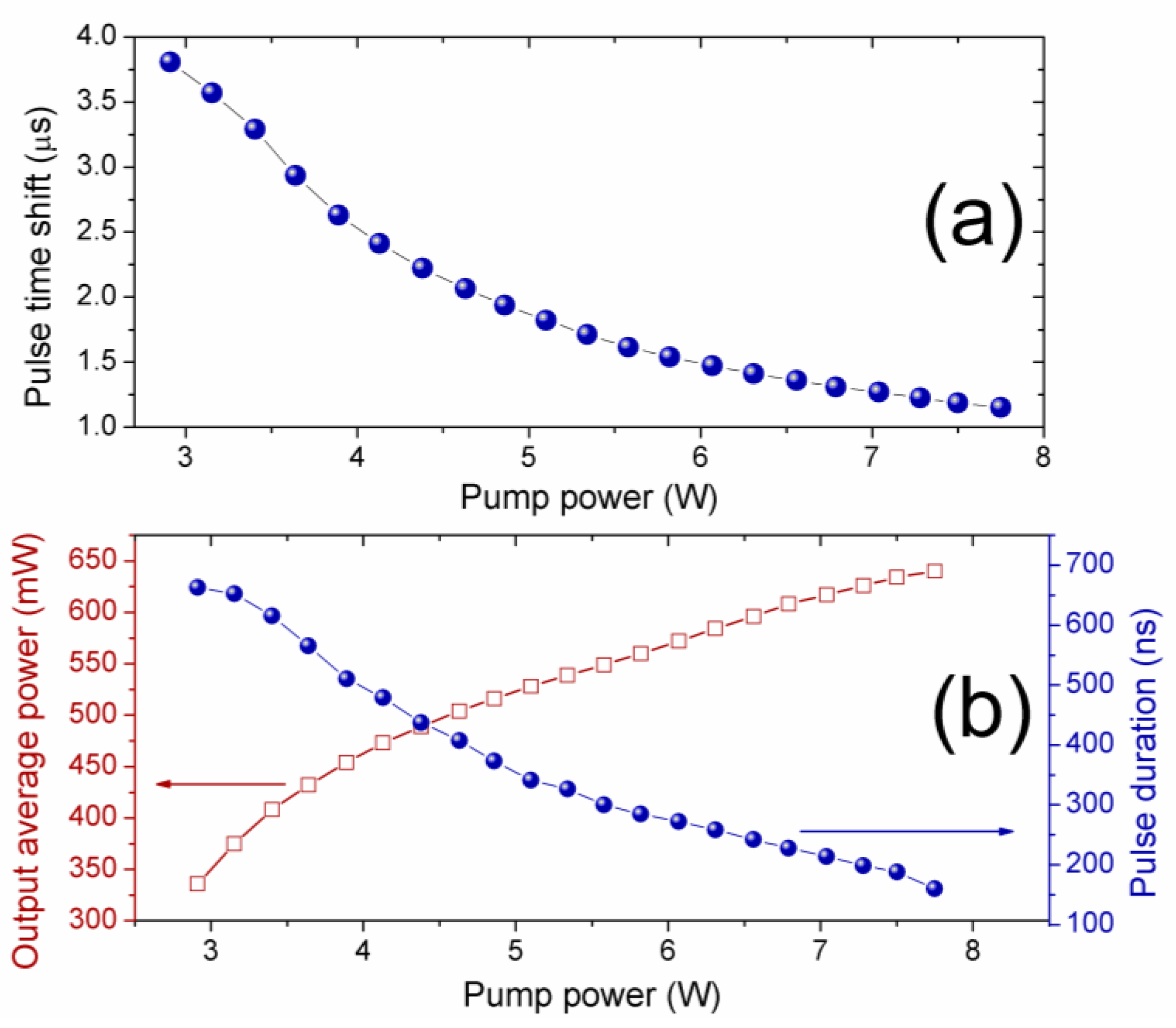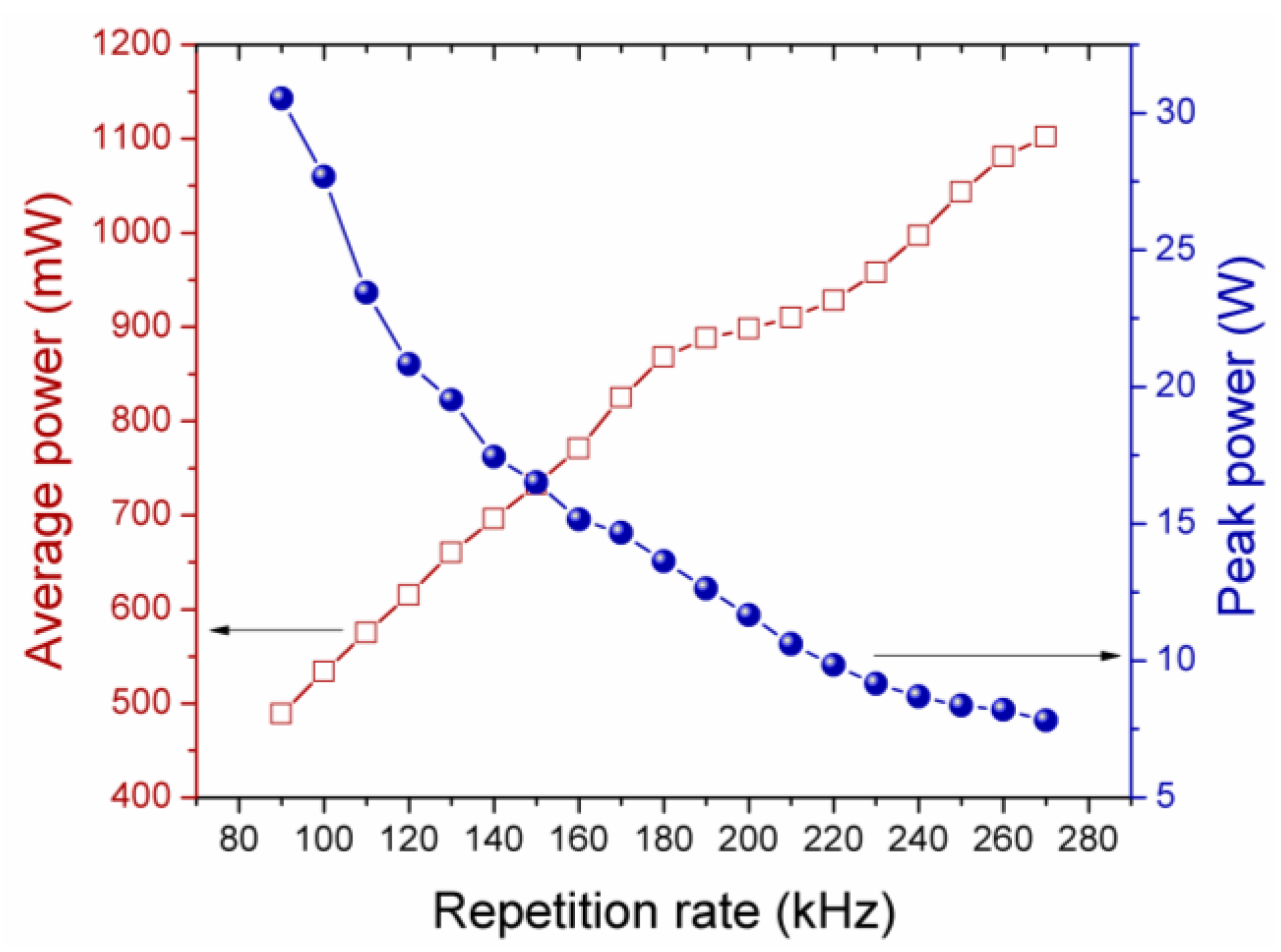Compact Narrow Linewidth Actively Q-Switched Er–Yb Double-Clad Fiber Laser
Abstract
:1. Introduction
2. Experimental Setup
3. Results and Discussion
4. Conclusions
Acknowledgments
Author Contributions
Conflicts of Interest
References
- Williams, R.J.; Javanovic, N.; Marshall, G.D.; Withford, M.J. All-optical, actively Q-switched fiber laser. Opt. Express 2010, 18, 7714–7723. [Google Scholar] [CrossRef] [PubMed]
- Peng, B.; Liu, Q.; Gong, M.; Yan, P. Acousto-optic Q-switched cladding-pumped ytterbium-doped fiber laser. Chin. Opt. Lett. 2007, 5, 415–417. [Google Scholar]
- Andersen, T.V.; Pérez-Millan, P.; Keiding, S.R.; Agger, S.; Duchowicz, R.; Andrés, M.V. All-fiber actively Q-switched Yb-doped laser. Opt. Commun. 2006, 260, 251–256. [Google Scholar] [CrossRef]
- Nilsson, J.; Alam, S.U.; Alvarez-Chavez, J.A.; Turner, P.W.; Clarkson, W.A.; Grudinin, A.B. High-power and tunable operation of erbium–ytterbium co-doped cladding- pumped fiber lasers. IEEE J. Quantum Electron. 2003, 39, 987–994. [Google Scholar] [CrossRef]
- González-García, A.; Ibarra-Escamilla, B.; Pottiez, O.; Kuzin, E.A.; Maya-Ordoñez, F.; Durán-Sánchez, M.; Deng, C.; Haus, J.W.; Powers, P.E. High efficiency, actively Q-switched Er/Yb fiber laser. Opt. Laser Technol. 2013, 48, 182–186. [Google Scholar] [CrossRef]
- Richardson, D.J.; Nilsson, J.; Clarkson, W.A. High power fiber lasers: Current status and future perspectives. J. Opt. Soc. Am. 2010, 27, B63–B92. [Google Scholar] [CrossRef]
- Cao, W.J.; Wang, H.Y.; Luo, A.P.; Xu, W.C. Graphene-based, 50 nm wide-band tunable passively Q-switched fiber laser. Laser Phys. Lett. 2012, 9, 54–58. [Google Scholar] [CrossRef]
- Dong, B.; Liaw, C.Y.; Hao, J.; Hu, J. Nanotube Q-switched low-threshold linear cavity tunable erbium-doped fiber laser. Appl. Opt. 2010, 49, 5989–5992. [Google Scholar] [CrossRef]
- Zhou, D.P.; Wei, L.; Dong, B.; Liu, W.K. Tunable passively Q-switched Erbium-Doped fiber laser with carbon nanotubes as a Saturable Absorber. IEEE Photon. Technol. Lett. 2010, 22, 9–11. [Google Scholar] [CrossRef]
- Liu, H.H.; Chow, K.K.; Yamashita, S.; Set, S.Y. Carbon-nanotube-based passively Q-switched fiber laser for high energy pulse generation. Opt. Laser Technol. 2013, 45, 713–716. [Google Scholar] [CrossRef]
- Kurkov, A.S. Q-switched all-fiber lasers with saturable absorbers. Laser Phys. Lett. 2011, 8, 335–342. [Google Scholar] [CrossRef]
- Pedra, C.E.; Ravet, G.; Mégret, P. Expermiental demonstration of a passive all-fiber Q-switched erbium- and samarium-doped laser. Opt. Lett. 2012, 37, 629–631. [Google Scholar]
- Durán-Sánchez, M.; Álvarez-Tamayo, R.I.; Pottiez, O.; Ibarra-Escamilla, B.; Hernández-García, J.C.; Beltrán-Pérez, G.; Kuzin, E.A. Actively Q-switched dual-wavelength laser with double-cladding Er/Yb-doped fiber using a Hi-Bi Sagnac interferometer. Laser Phys. Lett. 2015, 12, 025102. [Google Scholar] [CrossRef]
- Delgado-Pinar, M.; Zalvidea, D.; Díez, A.; Pérez-Millán, P.; Andrés, M.V. Q-switching of an all-fiber laser by acouto-optic modulation of a fiber Bragg grating. Opt. Express 2006, 14, 1106–1112. [Google Scholar] [CrossRef] [PubMed]
- Chen, N.K.; Feng, Z.Z.; Liaw, S.K. All-fiber pulsewidth tunable actively Q-switched erbium fiber laser using abrupt-tapered Mach-Zehnder block filter. Laser Phys. Lett. 2010, 7, 363–366. [Google Scholar] [CrossRef]
- Escalante-Zarate, L.; Barmenkov, Y.O.; Kolpakov, S.A.; Cruz, J.L.; Andrés, M.V. Smart Q-switching for single-pulse generation in an erbium-doped fiber laser. Opt. Express 2012, 20, 4397–4402. [Google Scholar] [CrossRef] [PubMed]
- Durán-Sánchez, M.; Kuzin, E.A.; Pottiez, O.; Ibarra-Escamilla, B.; González-García, A.; Maya-Ordoñez, F.; Álvarez-Tamayo, R.I.; Flores-Rosas, A. Tunable dual-wavelength actively Q-switched Er/Yb doublé-clad fiber laser. Laser Phys. Lett. 2014, 11, 015102. [Google Scholar] [CrossRef]
- Zhang, S.-M.; Lu, F.-Y.; Wang, J. All-fiber actively Q-Switched Er3+/Yb3+ co-doped ring laser. Microw. Opt. Technol. Lett. 2007, 49, 2183–2186. [Google Scholar] [CrossRef]






© 2017 by the authors. Licensee MDPI, Basel, Switzerland. This article is an open access article distributed under the terms and conditions of the Creative Commons Attribution (CC BY) license (http://creativecommons.org/licenses/by/4.0/).
Share and Cite
Posada-Ramírez, B.; Durán-Sánchez, M.; Alvarez-Tamayo, R.I.; Alaniz-Baylón, J.; Salceda-Delgado, G.; Kuzin, E.A.; Ibarra-Escamilla, B. Compact Narrow Linewidth Actively Q-Switched Er–Yb Double-Clad Fiber Laser. Fibers 2017, 5, 21. https://doi.org/10.3390/fib5020021
Posada-Ramírez B, Durán-Sánchez M, Alvarez-Tamayo RI, Alaniz-Baylón J, Salceda-Delgado G, Kuzin EA, Ibarra-Escamilla B. Compact Narrow Linewidth Actively Q-Switched Er–Yb Double-Clad Fiber Laser. Fibers. 2017; 5(2):21. https://doi.org/10.3390/fib5020021
Chicago/Turabian StylePosada-Ramírez, Berenice, Manuel Durán-Sánchez, Ricardo I. Alvarez-Tamayo, Jared Alaniz-Baylón, Guillermo Salceda-Delgado, Evgeny A. Kuzin, and Baldemar Ibarra-Escamilla. 2017. "Compact Narrow Linewidth Actively Q-Switched Er–Yb Double-Clad Fiber Laser" Fibers 5, no. 2: 21. https://doi.org/10.3390/fib5020021




